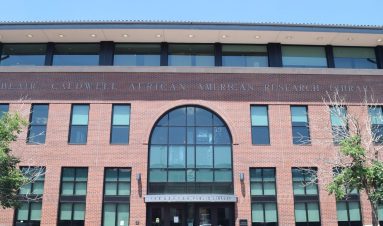Rossonian
2650 Welton Street
Fast Facts
Architect: George Louis Bettcher
Architectural Style: Beaux Arts
Year Built: 1907
Designation: Denver Landmark Denver Landmark District National Register of Historic Places
Neighborhood: Five Points
Original Building: Baxter Hotel
Handicap Accessible
New DOD Location
THE ROSSONIAN: A TRUE FIVE POINTS BEAUX-ARTS GEM
If you could meet one of the Rossonian’s famous guests, who would it be?
One of the most important buildings in Denver’s Five Points neighborhood, the Rossonian Hotel opened in 1912 as the Baxter Hotel. Robert Y. Baxter, who owned the Baxter Cigar Company, hired architect George Louis Bettcher to design a hotel on Welton Street at the Five Points intersection. With its triangular shape and Beaux-Arts style, the three-story Baxter Hotel quickly became a neighborhood landmark. In 1929, the hotel was renamed the Rossonian Hotel, and its lounge acquired a reputation as the best jazz club between the Midwest and the West Coast, with performances by jazz greats such as Duke Ellington and Ella Fitzgerald. After the 1960s, as Denver’s African American population left Five Points, the hotel and lounge declined. This landmark 21,000-square-foot building, with an addition built in 1994, has been largely underutilized since the mid-20th century. Palisade Partners’ vision is to restore the Rossonian to its original uses – boutique hotel, restaurant and music venue, respecting the rich history of the neighborhood while being inclusive of the existing Five Points community.
Structure and History
Between the 1920s to the 1950s, the Rossonian Hotel was an integral institution in Five Points. Black musicians visiting Denver for performances were often turned away from downtown hotels, and ended up staying at the Rossonian. As a result, the first-floor Rossonian Lounge became the most important jazz club between Kansas City and Los Angeles. Top performers who passed through Denver often played there on off nights between concerts at larger venues downtown or late at night, after they had finished performing at other clubs and returned to the hotel. Among the list of hotel guests are Duke Ellington (who once spent a whole summer there), Count Basie, Nat King Cole, Billie Holiday and Ella Fitzgerald. The lounge became so well known as a jazz hot spot that it began to attract white patrons from other parts of the city.
Racial discrimination in Denver, including discrimination in hotel accommodations and housing, began to wane after the World War II. By the late 1950s and 1960s, black entertainers coming to the city had a choice of hotels and were no longer forced by necessity to stay in Five Points. The end of racially restrictive housing covenants allowed middle-class blacks to move to other parts of Denver and the suburbs (Wasinger, 2005). The Rossonian Lounge could no longer count on a steady stream of top talent, and the Five Points neighborhood as a whole lost population and wealth, causing businesses in the area to struggle. The Rossonian changed hands a number of times in the following years, with various renovations and upgrades, but was never as active as it had been during its heyday (Mauk, 2001).
During the 1990s and early 2000s, the Rossonian and the Five Points neighborhood began to be recognized for their historic significance. In 1995, the Rossonian was listed on the National Register of Historic Places, and in 2002, Welton Street became a Denver historic cultural district. In 2005, developer Carl Bourgeois acquired the Rossonian for $800,000. Bourgeois lived in Five Points and had worked on other buildings along Welton Street. He hoped to open a jazz club and restaurant, but plans fizzled in 2007 because of financing and infrastructure problems.
Development
Palisade Partners’ plan for the revitalization project is to restore the Rossonian Hotel in a way that preserves the rich jazz and African American culture and transforms it back into the living room of the community. Palisade has specifically asked the neighborhood what is most important for this building’s retail and office spaces as well as how the residential programs can meet neighborhood needs. Palisade also requested ideas and feedback on public art that will be incorporated into the building design.
The preliminary design calls for a ground floor restaurant of approximately 4,500 to 5,000 square feet, a basement jazz and music venue of approximately 3,000 square feet and a fourth-floor addition. Floors two through four will contain 41 hotel rooms. Palisade has partnered with Chauncey Billups on the restaurant and lounge at the Rossonian Hotel, which will be named after the basketball superstar. Chauncey grew up in the Park Hill and Five Points area and continues to maintain a presence and connection to the neighborhood (Palisade Partners Rossonian Fact Sheet).
Neighborhood
The Five Points area, which had seen a huge influx of black residents already in the 1890s, became majority black in the 1920s, as Denver’s housing market boomed. Discriminatory housing practices effectively kept Denver’s African American residents segregated in Five Points. By 1929, about 5,500 of Denver’s 7,000 blacks lived in the area, which was home to a growing district of black businesses along Welton Street. Around that time the Baxter Hotel, still owned by the Baxter family, came under black management and was renamed the Rossonian after manager A. W. L. Ross (Rossonian Hotel National Register of Historic Places Nomination Form).
References
Wasinger, H. 2005. From Five Points to Struggle Hill: The Race Line and Segregation in Denver. Colorado Heritage.
Rossonian Hotel National Register of Historic Places Nomination Form.
Mauck, L. 2001. Five Points Neighborhood of Denver, Images of America. Chicago: Arcadia Publishing.
Palisade Partners Rossonian Fact Sheet.
Download this site description here.
Map
Rossonian
2650 Welton Street, Denver, CO, USA
Nearby Sites
View All
studiotrope Design Collective
studiotrope Design Collective (sDC) is a multidisciplinary design firm that focuses on inspiring ...
More Info
RedLine Contemporary Art Center
RedLine Contemporary Art Center RedLine contributes to the revitalization of a declining warehou...
More Info
Blair-Caldwell African American Research Library
Blair-Caldwell African American Research Library Named for Omar Blair and Elvin Caldwell, the fi...
More Info